When you think of sneaker culture, you may think of guys who love rap music lined up outside of a Foot Locker waiting for the latest Air Jordan reissue to drop. You’d be right, of course, but those guys didn’t just pop up out of nowhere when Spike Lee said “It’s gotta be the shoes.” The sneaker’s history reaches back to the 1800s, when canvas-and-rubber was the height of luxury. An exhibition, The Rise of Sneaker Culture, opening July 10 at the Brooklyn Museum, and Out of the Box, the exhibition’s accompanying Rizzoli book, trace the sneaker’s evolution from humble utilitarian footwear to fashion icon.
Elizabeth Semmelhack, senior curator at the Bata Shoe Museum in Toronto, where the exhibition was conceptualized and first shown, told ANIMAL that her idea for the show came from people assuming that the Bata Shoe Museum was only for women — as if men don’t wear shoes. Society suggests that women are hard-wired to love shoes in a way that men just don’t understand, but that belief contradicts songs like “My Adidas” and how devoted some men are to keeping their Jordans crispy. Semmelhack thought that taking a close look at sneaker culture would balance the “women love shoes” narrative (women love sneakers too, but the cultural assumption of the “sneakerhead” is young, urban and male). And in order to understand that, Semmelhack had to look at why sneakers came into being in the first place and how they evolved over time.
“One of the continuities throughout sneaker history is this drive through design and production for innovation,” Semmelhack says. The sneaker couldn’t have been invented if innovators like Charles Goodyear hadn’t figured out how to stabilize the sap of the rubber tree through the process of vulcanization. Rubber became the “sinew of the Industrial Age.” The Industrial Age created a wealthy upper middle class that was proud of its newfound leisure time. Sneakers were the footwear of playtime and therefore wearing them conveyed status (plus, rubber was really expensive back then).

Converse Rubber Shoe Company. All Star/Non Skid, 1917. Converse Archives. (Photo: Courtesy American Federation of Arts)
Sneakers lost that image as a status symbol between the 1930s and the 1970s, Semmelhack says, because they became widely available, and then were associated with childhood. But they came roaring back in the ‘70s, when running and basketball sneakers became must-haves.
Then in the ‘80s, Air Jordans and Run-DMC changed the game and ushered in the modern era of sneaker culture.

Air Jordan I, 1985. Nike Archives. (Photo: Ron Wood. Courtesy American Federation of Arts/Bata Shoe Museum)
“Basketball shoes more than anything became the height of fashion,” says Semmelhack.
And now, in 2015, the all-white sneaker is the most fashionable footwear, which brings sneakers full circle, going way, way back as a signifier of status.
“It goes all the way back to the 19th century, when summer whites were meant to be maintained,” Semmelhack says. “That pristine, crisp white look has for a long time in sneaker history conveyed that sense of privilege.”

Common Projects Achilles Low, 2015. Collection of Common Projects. (Photo: Courtesy American Federation of Arts)
Contemporary sneaker designers should look at this book and exhibition for inspiration if they’re unfamiliar with history, because these old-time sneakers are dope. The circle is so complete that these early sneakers look very fashionable to these modern eyes.
“Good design lasts!” Semmelhack says with a laugh at this observation.
And for the record, her favorite sneaker is the Adidas Superstar, aka the shelltoe, the iconic shoe of hip-hop’s Golden Age.
The exhibition will arrive at the Brooklyn Museum on July 10, thanks to the support of the American Federation of Arts. The exhibition features approximately 150 pairs of sneakers, including classics from Adidas, Converse, Nike, Puma, and Reebok; pieces from the private collections of Darryl “DMC” McDaniels and DJ/sneaker expert Bobbito Garcia; and high-fashion sneakers from Prada and designed by artists Damien Hirst and Kehinde Wiley.
(Photo: Ron Wood/Courtesy American Federation of Arts/Bata Shoe Museum)


